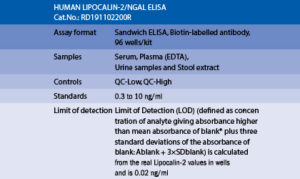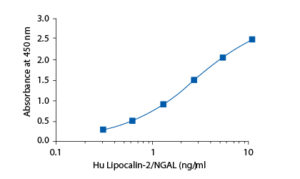Lipocalin-2/NGAL Human ELISA
Lipocalin-2 (LCN2) is a 25 kDa secretory glycoprotein, also called NGAL (neutrophil gelatinase-associated lipocalin); NL (neutrophil lipocalin); p25; oncogen 24p3 and 25 kDa alpha-2-microglobulin-related subunit of MMP-9 (LCN2 forms a covalently linked, disulfide-bridged heterodimer with the 92 kDa type V collagenase (MMP-9)). LCN2 is predominantly expressed in adipose tissue and liver. It belongs to the lipocalin superfamily that consists of over 20 small secretory proteins. Lipocalin folds consist of 8 antiparallel ß-sheets that surround a hydrophobic pocket. A common feature of this protein family, following from its structure, is its capacity to bind and transport small lipophilic substancies such as free fatty acids, retinoids, arachidonic acid and various steroids. Although Lipocalin-2 was identified more than a decade ago, the physiologic function of this protein remains poorly understood. LCN2 appears to be upregulated in cells under the “stress” (e.g. from infection, inflammation, in tissues undergoing involution to ischemia or neoplastic transformation). Plasma levels of LCN2 rise in inflammatory or infective condition. It mediates an immune response to bacterial infection by sequestering iron. In this case, LCN2 may represent a promising candidate as a therapeutic agent against bacterial infection. Several recent reports suggest that LCN2 might represent a sensitive biomarker for early renal injury. In cardiopulmonary bypass-induced acute renal injury and cisplatin-induced nephrotoxic injury, increased de novo synthesis of LCN2 in proximal tubule cells leads to sharply increased concentration of this protein in both urine and serum. LCN2 might also be critical for normal kidney formation in the earliest stages of mammalian development. LCN2 may play an important role in breast cancer, in complex with MMP-9, by protecting MMP-9 from degradation thereby enhancing its enzymatic activity and facilitating angiogenesis and tumor growth. LCN2 is also highly expressed after malignant transformation of the lung, colon and pancreatic epithelia. Circulating levels of LCN2 play a causative role in pathogenesis of obesity-induced metabolic disorders such as insulin resistance, Type 2 Diabetes Mellitus and cardiovascular disorders. In addition, serum LCN2 concentrations were positively associated with adipocyte-fatty acid binding protein (A-FABP), a novel serum marker for adiposity and metabolic syndrome.
The RD191102200R Human Lipocalin-2/NGAL ELISA is a sandwich enzyme immunoassay for the quantitative measurement of human lipocalin-2 in serum, plasma and urine samples.
In the BioVendor Human Lipocalin-2/NGAL ELISA, standards, quality controls and samples are incubated in microplate wells pre-coated with polyclonal anti-human lipocalin-2 antibody. After one hour incubation and washing, biotin labelled polyclonal anti-human lipocalin-2 antibody is added and incubated with captured lipocalin-2 for one hour. After another washing, streptavidin-HRP conjugate is added. After 30 minutes incubation and the last washing step, the remaining conjugate is allowed to react with the substrate solution (TMB). The reaction is stopped by addition of acidic solution and absorbance of the resulting yellow product is measured. The absorbance is proportional to the concentration of lipocalin-2. A standard curve is constructed by plotting absorbance values against concentrations of standards, and concentrations of unknown samples are determined using this standard curve.
Intended use
Clinical Application
Test principle


Summary of protocol
– Almalki WH, Abdalla AN, Elkeraie AF, Abdelhadi AM, Elrggal M, Elrggal ME. Effect of fluorescein angiography on renal functions in type 2 diabetes patients: A pilot study. Saudi J Kidney Dis Transpl. 2017 May-Jun;28(3):491-498
– Baumert M, Surmiak P, ORCID: http://orcid.org/0000-0003-3662-634X, Wiecek A, Walencka Z. Serum NGAL and copeptin levels as predictors of acute kidney injury in asphyxiated neonates. Clin Exp Nephrol. 2016 Sep 2;
– Bayram A,Esmaoglu A, Akin A,Baskol G, Aksu R, Bicer C, Demirtas A, Mutluay R, Boyaci A. The effects of intraoperative infusion of dexmedetomidine on early renal function after percutaneous nephrolithotomy. Acta Anaesthesiologica Scandin. 2011; 55; (539–544)
– Borkham-Kamphorst E, van de Leur E, Zimmermann HW, Karlmark KR, Tihaa L, Haas U, Tacke F, Berger T, Mak TW, Weiskirchen R. Protective effects of lipocalin-2 (LCN2) in acute liver injury suggest a novel function in liver homeostasis. Biochim Biophys Acta. 2013 May;1832 (5):660-73
– Chen HH, Lan YF, Li HF, Cheng CF, Lai PF, Li WH, Lin H. Urinary miR-16 transactivated by C/EBPbeta reduces kidney function after ischemia/reperfusion-induced injury. Sci Rep. 2016;6:27945
– Corripio R, Gonzalez-Clemente JM, Perez-Sanchez J, Naf S, Gallart L, Nosas R, Vendrell J, Caixas A. Weight loss in prepubertal obese children is associated with a decrease in adipocyte fatty-acid-binding protein without changes in lipocalin-2: a 2-year longitudinal study. Eur J Endocrinol. 2010 Dec;163 (6):887-93
– Issa VS, Andrade L, Ayub-Ferreira SM, Bacal F, de Braganca AC, Guimaraes GV, Marcondes-Braga FG, Cruz FD, Chizzola PR, Conceicao-Souza GE, Velasco IT, Bocchi EA. Hypertonic saline solution for prevention of renal dysfunction in patients with decompensated heart failure. Int J Cardiol. 2013 Jul 15;167 (1):34-40
– Kiskac M, Zorlu M, Akkoyunlu ME, Kilic E, Karatoprak C, Cakirca M, Yavuz E, Ardic C, Camli AA, Cikrikcioglu M, Kart L. Vaspin and lipocalin-2 levels in severe obsructive sleep apnea. J Thorac Dis. 2014 Jun;6 (6):720-5
– Kraydaschenko O, Berezin A, Dolinnaya M. Serum Cystatin C and Neutrophil Gelatinase-Associated Lipocalin as Biomarkers of Glomerular and Tubular Kidney Damage in Patients with Chronic Glomerulonephritis and Saved Renal Function. Biological Markers and Guided . July 2016;3 (1):147-154
– Luque-Ramirez M, Martinez-Garcia MA, Montes-Nieto R, Fernandez-Duran E, Insenser M, Alpanes M, Escobar-Morreale HF. Sexual dimorphism in adipose tissue function as evidenced by circulating adipokine concentrations in the fasting state and after an oral glucose challenge. Hum Reprod. 2013 Jul;28 (7):1908-18
– Mady GAS, Nabi AAAA, Shawky SM, Baki AH, Elgaaly SA. Urinary Neutrophil Gelatinase Associated Lipocalcin (uNGA|L) as an early marker for contrast induced acute kidney injury after cardiac catheterization. International Journal of Advan. 2016;3 (6)
– Panidis D, Tziomalos K, Koiou E, Kandaraki EA, Tsourdi E, Delkos D, Kalaitzakis E, Katsikis I. The effects of obesity and polycystic ovary syndrome on serum lipocalin-2 levels: a cross-sectional study. Reprod Biol Endocrinol. 2010;8:151
– Patel ML, Sachan R, Shyam R, Kumar S, Kamal R, Misra A. Diagnostic accuracy of urinary neutrophil gelatinase-associated lipocalin in patients with septic acute kidney injury. International Journal of Nephr. July 2016;:161-169
– Roth GA, Nickl S, Lebherz-Eichinger D, Schmidt EM, Ankersmit HJ, Faybik P, Hetz H, Krenn CG. Lipocalin-2 serum levels are increased in acute hepatic failure. Transplant Proc. 2013 Jan-Feb;45 (1):241-4
– Santana-Santos E, Gowdak LH, Gaiotto FA, Puig LB, Hajjar LA, Zeferino SP, Drager LF, Shimizu MH, Bortolotto LA, De Lima JJ. High Dose of N-Acetylcystein Prevents Acute Kidney Injury in Chronic Kidney Disease Patients Undergoing Myocardial Revascularization. Ann Thorac Surg. 2014 Mar 20;
– Scheer FA, Chan JL, Fargnoli J, Chamberland J, Arampatzi K, Shea SA, Blackburn GL, Mantzoros CS. Day/night variations of high-molecular-weight adiponectin and lipocalin-2 in healthy men studied under fed and fasted conditions. Diabetologia. 2010 Nov;53 (11):2401-5
– Sigdel KR, Duan L, Wang Y, Hu W, Wang N, Sun Q, Liu Q, Liu X, Hou X, Cheng A, Shi G, Zhang Y. Serum Cytokines Th1, Th2 and Th17 Expression Profiling In Active Lupus Nephritis-IV: From a Southern Chinese Han Population.
– Stejskal D, Karpisek M, Humenanska V, Hanulova Z, Stejskal P, Kusnierova P, Petzel M. Lipocalin-2: development, analytical characterization, and clinical testing of a new ELISA. Horm Metab Res. 2008 Jun;40 (6):381-5
– Vesnina Z V, Lishmanov Y B, Alexandrova E A, Nesterov E A. Evaluation of Nephroprotective Efficacy of Hypoxic Preconditioning in Patients Undergoing Coronary Artery Bypass Surgery. Cardiorenal Medicine. 2016;6 (4)
– Yavuz S, Anarat A, Acarturk S, Dalay AC, Kesiktas E, Yavuz M, Acarturk TO. Neutrophil gelatinase associated lipocalin as an indicator of acute kidney injury and inflammation in burned children. Burns. 2014 Jun;40 (4):648-54
– Zorlu M, Kiskac M, Karatoprak C, Kesgin S, Cakirca M, Yildiz K, Ardic C, Cikrikcioglu MA, Erkoc R. Assessment of serum apelin and lipocalin-2 levels in patients with subclinical hypothyroidism. Ann Endocrinol (Paris). 2014 Feb;75 (1):10-4

